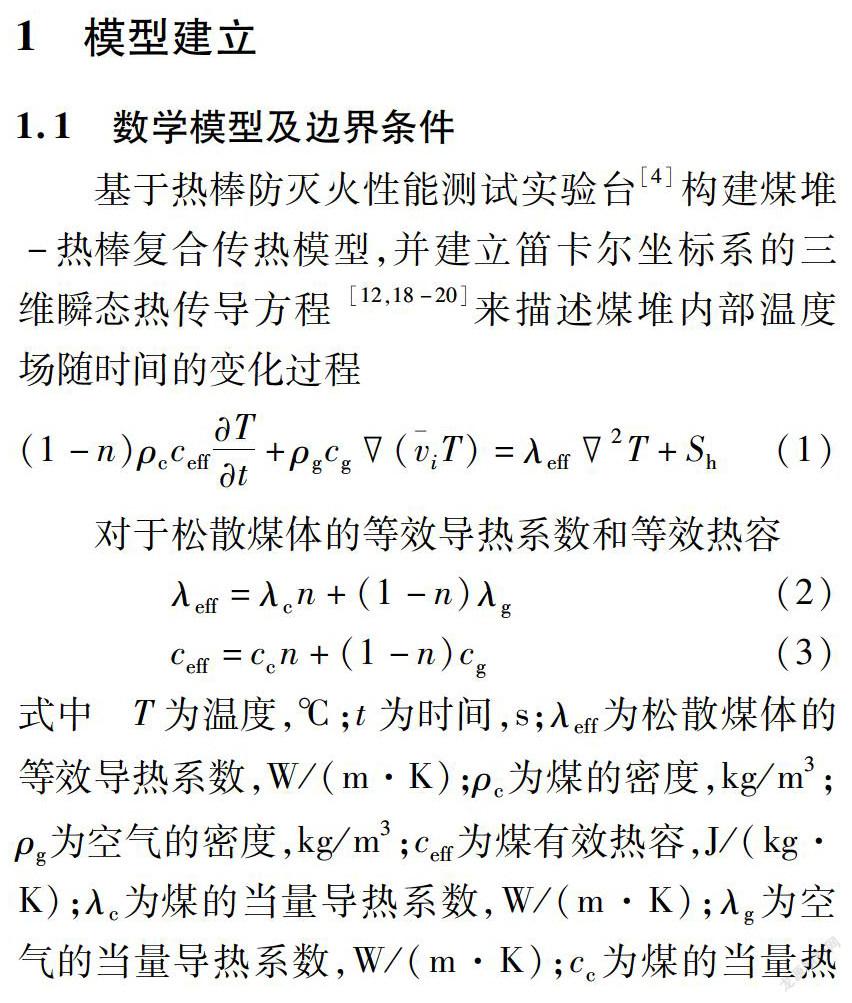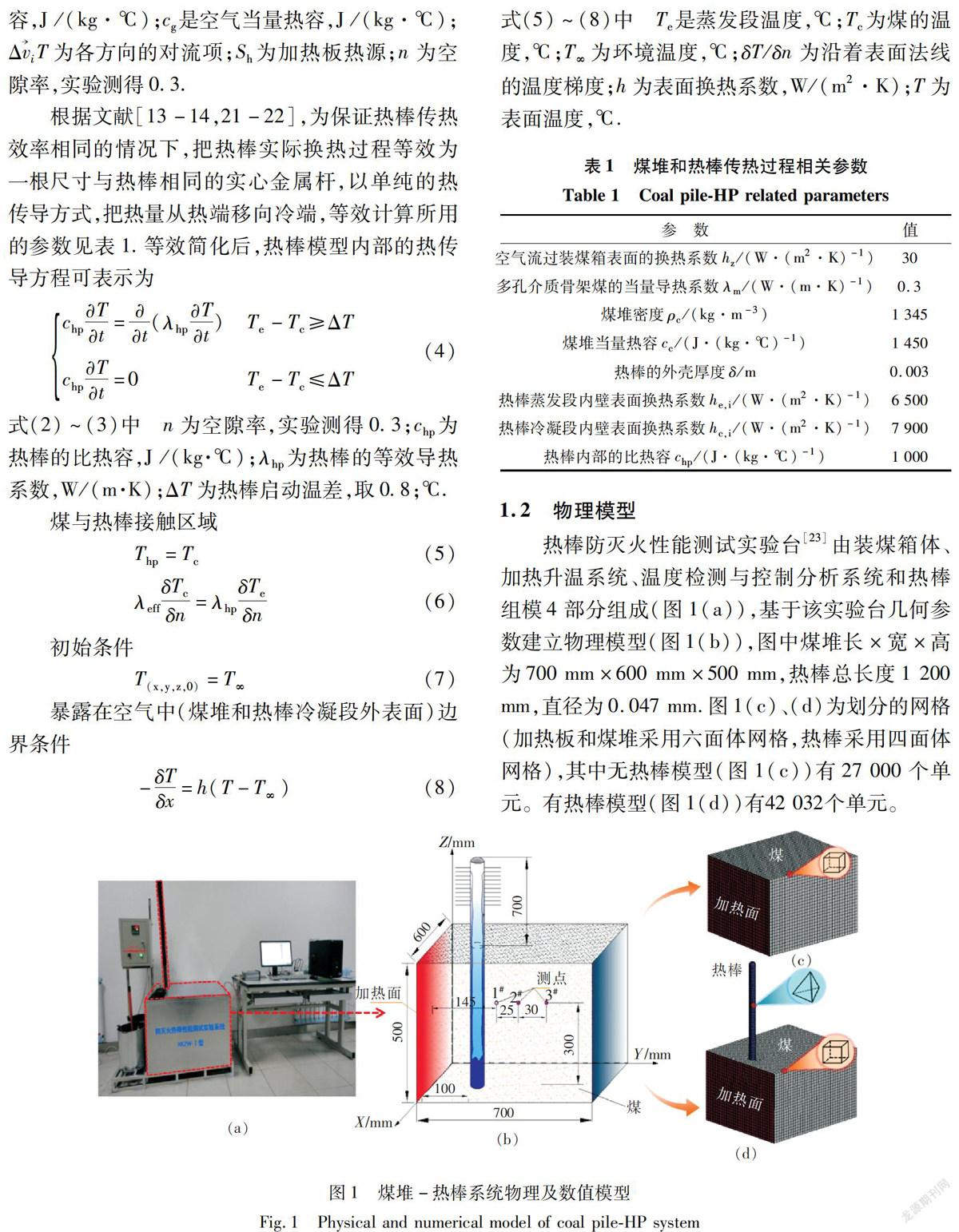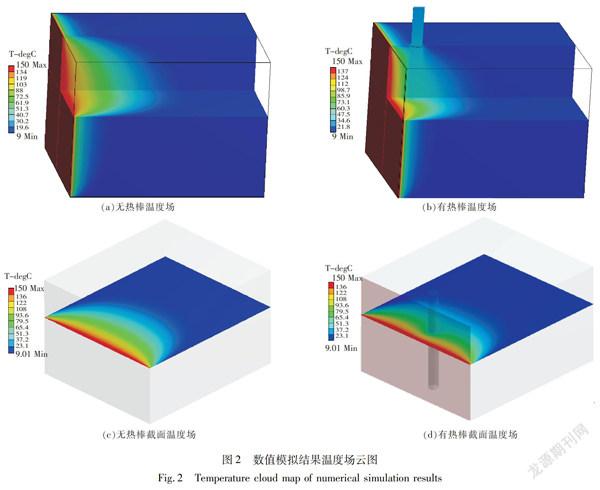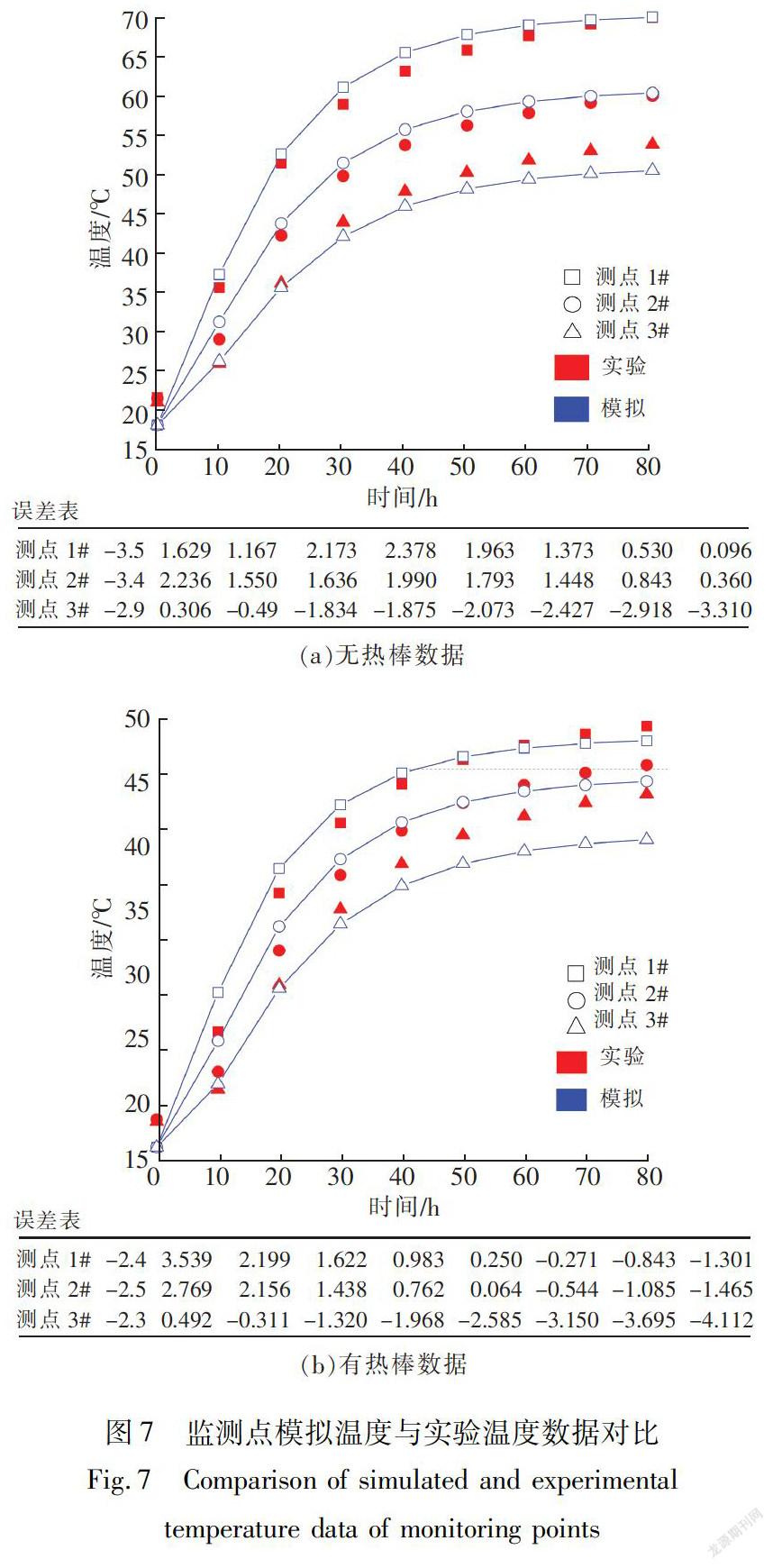基于热棒降温技术的自燃煤堆热迁移行为数值模拟
2019-09-10程方明常助川李贝
程方明 常助川 李贝






摘 要:为研究热棒作用下煤堆内部传热行为特征及冷却效果,在物理实验基础上,建立了煤堆-热棒系统复合传热模型,采用ANSYS模拟软件,对自燃煤堆在热棒作用下温度场进行数值模拟。通过分析有、无热棒时煤堆内的温度场及温度等值线的变化,对热棒的降温效果进行评价。结果表明,热棒可以改变煤堆内部的热传导路径,帮助煤堆散热。热棒的存在可以使温度等值线向热端移动,而且越靠近热棒位移量越大,形成包围热棒的“马鞍状”降温模态。根据热棒对松散煤体降温的效果,把热棒的作用范围划分为“敏感区”、“过渡区”、“迟钝区”三区,来有效判断热棒的降温半径,给实际应用中控制热棒的密度提供参考。对比实验和模拟结果,模拟值与实验实测值相近,精度较高。
关键词:煤自燃;热棒;数值模拟;温度等值线;温度场
中图分类号:TD 75 文献标志码:A
DOI:10.13800/j.cnki.xakjdxxb.2019.0404 文章编号:1672-9315(2019)04-0581-08
Abstract:In order to study the internal thermal migration behavior under the action of Heat Pipe(HP)in coal stockpile,the physical mathematical model of coal stockpile HP was established on the basis of physical experiment,and the temperature field of spontaneous combustion coal stockpile under the action of HP was numerically simulated by ANSYS simulation software.By analyzing the change of temperature field and temperature contour in coal stockpile with and without HP,the cooling effects of HP was evaluated.The results show that the HP can change the heat conduction path inside the coal stockpile and help the coal stockpile dissipate heat.The existence of a HP can make the temperature contour move toward the high temperature end,and the closer to the HP,the greater the displacement of the temperature contour,thus the final formation of the “saddle” cooling mode which surronds the HP is formed.According to the effects of HP cooling on the coal pile,the cooling range of the HP is divided into three areas:“sensitive area”,“transition area” and “transfer area”,to judge the cooling radius of the HP effectively,which provides a reference for controlling the density of HPs in practice.By comparing the experimental results,it can be seen that the simulated values are close to the experimental measured values with higher precesion.
Key words:coal spontaneous combustion;heat pipes;numerical simulation;temperature contour;temperature field
0 引 言
煤自燃释放的二氧化碳及其它有毒有害气体严重地影响人类健康并污染全球环境[1-2],其防治技术一直是煤矿安全的研究熱点。热棒作为一种单向导热能力极强的设备[3-7],具有破坏煤自燃蓄热环境的潜力,可作为防治煤自燃灾害的一种新型技术手段[8-11]。开展热棒对煤堆内部温度场分布影响的相关研究可为煤自燃移热技术研发奠定重要基础,促进热棒技术在煤矿安全领域发挥更大的作用。
Liang等研究发现刀具上40%的热量经由热管散失,刀具斜切面温度降低50 ℃,与物件接触点最高温度降低200 ℃,热量密度大时热管嵌入式刀具降温效果更佳[12]。Zhang等对冻土区隧道断面浅埋热棒群进行了数值模拟研究,发现热棒群可以使解冻深度变浅,有效地冷却浅埋隧道段的永久冻土,确保隧道的热稳定性[13]。Yu等通过对多年冻土区公路路基热棒的冷却性能分析发现,热棒的最大冷却深度约12 m,而且安装热棒后路面平均变形率是没安装前的6倍[14-15]。Chiou等把热管安装在切割工具上,通过实验和模拟证明了使用热管可以降低切具产生的热量,减少切削液的使用,从而切具寿命被延长,环境污染被降低[16]。屈瑞在煤垛中插入多根光管,当热管间距缩小、插入深度减小、热管布置角度减小时,发现可以有效提高煤堆的散热,当煤堆内部温度升高时,冷凝段加装翅片的热管降温效果更好[17]。邓军等通过研究热棒对煤堆升温过程的影响,发现热棒对煤堆420 mm范围的温度场有影响,距离热棒边缘半径20 mm处煤堆温度下降最为显著,随着距离热棒边缘半径尺寸的增大,热棒对煤堆内部温度场的分布影响逐渐减小[3]。
破坏蓄热环境,及时散除热量,对煤堆和煤矸石堆自燃防治至关重要,通过热棒来强化煤堆内部热量散失,能够有效防止煤自燃灾害发生[3]。然而,开展热棒对煤自燃影响的实验研究耗时较长,且现场情况复杂,实验条件难以准确控制,再现难度较大。因此,文中在热棒传热特性实验测试基础上,建立煤堆与热棒热传导的复合传热模型,利用ANSYS软件进行小规模数值模拟,通过模拟与实验结果的对比,定量分析热棒强化散热作用下煤堆内部冷却效果和传热行为,为大规模数值模拟提供重要思路和基础,对现场工程应用的优化设计与效果预测具有重要意义,为热棒防灭火技术的推广应用和相关工艺参数确定提供可靠的理论支持。
1 模型建立
1.1 数学模型及边界条件
1.2 物理模型
热棒防灭火性能测试实验台[23]由装煤箱体、加热升温系统、温度检测与控制分析系统和热棒组模4部分组成(图1(a)),基于该实验台几何参数建立物理模型(图1(b)),图中煤堆长×宽×高为700 mm×600 mm×500 mm,热棒总长度1 200 mm,直径为0.047 mm.图1(c)、(d)为划分的网格(加热板和煤堆采用六面体网格,热棒采用四面体网格),其中无热棒模型(图1(c))有27 000个单元。有热棒模型(图1(d))有42 032个单元。
为了对比有、无热棒对煤堆内部温度场的影响,在煤堆内部设置3组测温点,位置在高度Z=300 mm处的XY平面上,方向沿Y的正方向,距离加热面依次为145,170,200 mm处设置。当进行有热棒的实验和模拟时,热棒在煤中埋深500 mm,暴露于空气段700 mm,插入煤堆的位置在Y方向上距离加热面100 mm处,如图1(b)所示。
1.3 参数设置
物理实验在室内完成,由于室内的风速较小,因此被忽略不计,室内的环境温度范围为7~11 ℃,煤堆内的温度范围为9~11 ℃,实验中通过计算机控制,每10 h采集一次数据,总共实验时长80 h.为了使数值模拟结果可靠,模拟中把环境温度与煤堆初始温度设为10 ℃,加热板设为恒温150 ℃,模拟结束时间设为80 h.采集数据的位置与实验采集数据的位置相同,并设定每10 h输出一组测点数据,进而得出煤堆内部测点随时间变化的温度值。其余描述煤堆和热棒传热过程的部分关键参数是依据实验测得的数据设置,详见表1.
2 模擬结果分析及验证
2.1 结果分析
2.1.1 温度场分析
模拟80 h后,得到无热棒煤堆温度场(图2(a)、图2(c))和有热棒煤堆温度场(图2(b)、图2(d))。图2中,加热面处温度最高,内部温度场背向加热面凸出而呈拱形,温度值从热源端向右逐渐递减。而外壁与空气对流换热作用使其表面温度较低并呈现出深蓝色。对比无热棒模拟温度场结果(图2(c)),发现当插入热棒后(图2(d)),热棒与煤堆接触的周围温度场发生了改变,中间向里凹陷,呈现出“马鞍状”,表明热棒的存在,改变了热量的传导路径,使得热量不但可以从外壁流出,还可以通过热棒流出,证实了热棒用来移走煤堆内热量是可行的。
为了清晰观察横截面的温度场分布,基于图2横截面云图做出对应截面温度等值线图3,图3(a)中温度等值线呈波状从加热板(此后称为热端)向最远边界(此后称为冷端,其温度为环境温度10 ℃)扩散,越靠近热端,温度等值线越密集,温度梯度也越大,冷端则反之。在图3(b)中,因为热量被吸收的多少与离热棒距离呈正比,所以温度等值线弯曲程度不同[21],所以X在0~0.3 m的热棒主要影响区内,热量被吸收的更多,等值线弯曲程度也越大,呈现出“马鞍状”,因此该区域为温度梯度的“振荡区”。然而由于热棒降温能力的有限性,在图3(b)中,X在0.3~0.7 m的范围内,温度及温度梯度变化相对较为平缓,温度等值线稀疏,形状变化小甚至没变化,所以并没有呈现出“马鞍状”,因此该区域呈为温度梯度的“平缓区”。
由于温度场内等值线规律趋势类似,在此以6根温度等值线(从冷端至热端依次为10.0,13.0,18.8,29.7,45.0,62.5 ℃)为例进行分析。首先对所选的温度等值线的最大变形处(Y=0.3 m)做标记(无热棒标记为mn,有热棒标记为m′n),对比标记点的横坐标发现,同样的温度等值线,在有热棒的情况下,明显更加靠近热端,而且与环境温度相等的10 ℃等值线的前移,使得冷端区域变大,即热棒的存在使得温度场整体向热端收缩,温度等值线发生了位移,高温区因此减小。
2.2.2 煤堆内部测点监测值对比验证
图6是模拟与实验中测点的温度值以及模拟的误差值,分析实验数据与模拟数据,在图7(a)中,0~30 h内升温速率约0.7~1.3 ℃/h,30~50 h内,升温速率约0.2~0.4 ℃/h,50~80 h内,升温速率约0.09~0.17 ℃/h,在图6(b)中,在0~30 h内升温速率约0.7~1.03 ℃/h,30~50 h内,升温速率约0.25~0.3 ℃/h,50~80 h内,升温速率约0.03~0.2 ℃/h,显然无论有、无热棒,在前50 h内温度上升速率都较大,在50 h后升温速率逐渐减小,并随时间趋于平缓。计算1#,2#,3#各测点降温幅度,发现模拟中测点降温幅度依次为22.3,16.3,11.7 ℃,实验中测点的降温幅度依次是20.9,14.5,10.9 ℃,模拟趋势与实验趋势一致,降温幅度几乎相近。
与实验结果比较,模拟结果在各时刻都产生了一定的误差。其中在无热棒(图6(a))模拟结果中,测点在个别点误差较大,其他时刻模拟值的相对误差都在5%内。而插入热棒后(图6(b)),测点普遍相对误差接近或已超过5%,这是由于热棒的插入,使得影响煤堆内部温度的因素增多,例如对热棒模拟时的等效简化、热棒与煤体接触热阻的忽略等。但是从总体上,数值模拟曲线规律与实验一致,所得数据与实验结果相近,故模拟是可接受的、可靠的。
3 結 论
1)热棒的存在使得温度等值线向热端发生位移,温度等值线最大位移量ΔX与L呈反比,距热棒越近,最大位移量会越大,反之则越小,最终呈现出“马鞍”状,致使高温区域缩小。
2)根据热棒对松散煤体“抑制”作用,把热棒的作用范围划分为三区,即“敏感区”(L在0~0.2 m)、“过渡区”(L在0.2~0.35 m)、“迟钝区”(L在0.35~0.6 m),通过提出对热棒降温范围区域划分方法,可以有效判断热棒的降温半径,给实际中煤堆内插入热棒的密度提供新的方法及参考。
3)数值模拟与实验结果都表明热棒可降低煤堆内的温度,而且降温幅度与离热棒的距离呈反比,越靠近热棒的地方,降温幅度越大。虽然数值模拟的温度结果有一定的误差,但是模拟中测点的温度时程曲线变化规律与实验结果一致,而且误差较小,都在可接受范围内,因此该数值模拟方法及模型对研究煤堆热棒移热过程具有可行性。
参考文献(References):
[1] Stracher G B,Taylor T P.Coal fires burning out of control around the world:thermodynamic recipe for environmental catastrophe[J].International Journal of Coal Geology,2004,59(1):7-17.
[2]KONG Xiang guo,WANG En yuan,HU Shao bing,et al.Critical slowing down on acoustic emission characteristics of coal containing methane[J].Journal of Natural Gas Science and Engineering,2015,24:156-165.
[3]邓 军,李 贝,马 砺.用热棒技术强化煤堆降温幅度试验[J].中国安全科学学报,2015,25(6):62-67.
DENG Jun,LI Bei,MA Li.Strengthening the cooling amplitude of coal pile by heat pipe technology[J].China Safety Science Journal,2015,25(6):62-67.
[4]Narcy M,Lips S,Sartre V.Experimental investigation of a confined flat two phase thermosyphon for electronics cooling[J].Experimental Thermal and Fluid Science,2018,96:516-529.
[5]Shafieian A,Khiadani M,Nosrati A.A review of latest developments,progress,and applications of heat pipe solar collectors[J].Renewable and Sustainable Energy Reviews,2018,95:273-304.
[6]Knipper P,Bertsche D,Gneiting R,et al.Experimental investigation of heat transfer and pressure drop during condensation of R134a in multiport flat tubes[J].International Journal of Refrigeration,2019,98:211-221.
[7]YUE Chang,ZHANG Quan,ZHAI Zhi qiang.CFD simulation on the heat transfer and flow characteristics of a microchannel separate heat pipe under different filling ratios[J].Applied Thermal Engineering,2018,139:25-34.
[8]LI Bei,DENG Jun,YANG Xiao,et al.Heat transfer capacity of heat pipes:an application in coalfield wildfire in China[J].Heat and Mass Transfer,2018,54(6):1755-1766.
[9]ZHANG Hong,ZHUANG Jun.Research,development and industrial application of heat pipe technology in China[J].Applied Thermal Engineering,2003,23(9):1067-1083.
[10]XIA Tong qiang,ZHOU Fu bao,GAO Feng,et al.Simulation of coal self heating processes in underground methane rich coal seams[J].International Journal of Coal Geology,2015,141-142:1-12.
[11]Hussam J,Sulaiman A,Amisha C,et al.Experimental and theoretical investigation of a flat heat pipe heat exchanger for waste heat recovery in the steel industry[J].Energy,2017,141:1928-1939
[12]LIANG Liang,QUAN Yan ming,KE Zhi yong.Investigation of tool chip interface temperature in dry turning assisted by heat pipe cooling[J].The International Journal of Advanced Manufacturing Technology,2011,54(1):35-43.
[13]ZHANG Ming yi,PEI Wan sheng,LAI Yuan ming,et al.Numerical study of the thermal characteristics of a shallow tunnel section with a two phase closed thermosyphon group in a permafrost region under climate warming[J].International Journal of Heat and Mass Transfer,2017,104:952-963.
[14]YU Fan,QI Ji jin,ZHANG Ming yi,et al.Cooling performance of two phase closed thermosyphons installed at a highway embankment in permafrost regions[J].Applied Thermal Engineering,2016,98:220-227.
[15]YU Fan,ZHANG Ming yi,LAI Yuan ming,et al.Crack formation of a highway embankment installed with two phase closed thermosyphons in permafrost regions:field experiment and geothermal modelling[J].Applied Thermal Engineering,2017,115:670-681.
[16]Chiou R Y,Lu L,Chen J S J,et al.Investigation of dry machining with embedded heat pipe cooling by finite element analysis and experiments[J].The International Journal of Advanced Manufacturing Technology,2007,31(9-10):905-914.
[17]屈 锐.重力热管提取储煤堆自燃热量的实验研究[D].西安:西安科技大学,2014.
QU Rui.Experimental study on extracting spontaneous combustion heat of coal storage pile by gravity heat pipe[D].Xi’an:Xi’an University of Science and Technology,2014.
[18]朱红青,刘星魁.尾巷瓦斯抽采下采空区煤自燃升温的数值模拟[J].西安科技大学学报,2012,32(1):1-7.
ZHU Hong qing,LIU Xing kui.Numerical simulation of coal spontaneous combustion heating in goaf under gas extraction in tail lane[J].Journal of Xi’an University of Science and Technology,2012,32 (1):1-7.
[19]文 虎,師吉林,翟小伟,等.大断面全煤巷高冒区自燃过程的三维数值模拟[J].西安科技大学学报,2012,32(5):537-542.
WEN Hu,SHI Ji lin,ZHAI Xiao wei,et al.Three dimensional numerical simulation of spontaneous combustion process in high rise section of large section coal roadway[J].Journal of Xi’an University of Science and Technology,2012,32(5):537-542.
[20]杨世铭,陶文铨.传热学(4版)[M].北京:高等教育出版社,2006.
YANG Shi ming,TAO Wen zhao.Heat transferology(4th ed)[M].Beijing:Higher Education Press,2006.
[21]周圆圆.埋地重力热管传热性能的研究[D].北京:中国石油大学,2008.
ZHOU Yuan yuan.Study on heat transfer performance of buried gravity heat pipe[D].Beijing:China University of Petroleum,2008.
[22]郭春香,吴亚平.热棒材料高导热性对其降温效果影响的三维非线性有限元分析[J].兰州交通大学学报,2013,32(1):25-29.
GUO Chun xiang,WU Ya ping.Three dimensional nonlinear finite element analysis of the effect of high thermal conductivity of heat pipe materials on its cooling effect[J].Journal of Lanzhou Jiaotong University,2013,32(1):25-29.
[23]吴 鹏.热棒布置参数与环境风速对煤堆移热实验研究[D].西安:西安科技大学,2018.
WU Peng.Experimental study on heat transfer of coal piles with heat pipe arrangement parameters and ambient wind speed[D].Xi’an:Xi’an University of Science and Technology,2018.
